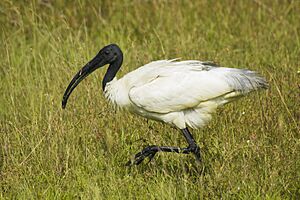Black-headed ibis facts for kids
Quick facts for kids Black-headed ibis |
|
|---|---|
 |
|
| Conservation status | |
| Scientific classification | |
| Synonyms | |
|
Tantalus melanocephalus Latham, 1790 |
The Black-headed Ibis (Threskiornis melanocephalus) is a special wading bird. It is also called the Oriental White Ibis or Indian White Ibis. This bird lives in South and Southeast Asia, from India to Japan. It is the only ibis in its home region that is mostly white. It has a black neck and head. Its long, curved beak and legs are also black.
Even though it's a wetland bird, the Black-headed Ibis finds food in many places. These include natural areas and places made by people. This type of ibis builds its nests only when it is the rainy season.
Contents
What Does the Black-headed Ibis Look Like?
The Black-headed Ibis is a large waterbird. Adult birds are about 65 to 76 centimeters (25 to 30 inches) long. Their white feathers stand out against their bare black neck and head. They also have a black beak that curves downwards.
During the breeding season, the tail feathers of adults turn jet black. Normally, these feathers are light grey. Also, bare skin patches under their wings become blood-red. The heads of some breeding adults might look bluish. Very rarely, they can have a pink or bright red spot behind the neck. Some breeding adults also grow white feathers behind their neck. Sometimes, their chest and back can turn yellowish.
Young ibises look different from adults. They have grayish feathers on their neck. Their wings and back have speckled brown-grey feathers. Like storks, these birds do not have a true voice box. They are mostly silent. They only make soft grunting sounds when they are at their nest.
Where Do Black-headed Ibises Live?
Black-headed Ibises live naturally in many countries. These include Bangladesh, Cambodia, China, Hong Kong, India, and Indonesia. They also live in Malaysia, Myanmar, Nepal, Pakistan, and the Philippines. You can also find them in the Russian Federation, Sri Lanka, Thailand, and Vietnam.
Sometimes, they travel to other places. These include Japan, South Korea, Laos, and Mongolia. They are common breeding birds in India, Sri Lanka, Nepal, and Myanmar. However, their numbers have dropped a lot in Cambodia, Indonesia, Malaysia, Thailand, and Vietnam. The fastest decline has been seen in Sumatra.
What Kinds of Places Do They Use?
The Black-headed Ibis can live in many different places. They use both natural areas and places made by humans. These include freshwater and saltwater marshes. They also live near lakes, ponds, and rice fields. You can find them in freshly plowed farm fields and irrigation canals. They also use riverbanks, reservoirs, and city lakes. Sometimes, they even visit open sewage gutters, grazing areas, and garbage dumps.
Ibises change where they look for food depending on the season. For example, in parts of India, they use different places in summer and monsoon. In summer, they prefer natural marshes and empty fields. But during the monsoon, they spread out more. They start using various farm fields too.
In cities, more ibises are found near crop fields, wetlands, and open spaces. In areas with more forests and rocky hills, wetlands are their favorite places all year. They do not change their habitat use much between seasons there. Inside towns, more ibises are seen. Open sewage lines are used more in dry summers. Ibises also use grazing lands more during the monsoon season.
Nesting and Daily Life
Black-headed Ibises build their nests in large groups called heronries. These are usually close to wetlands. Their nests are made of sticks and lined with grass and other soft materials. They often use old trees in cities for sleeping at night and for nesting.
Studies show that Black-headed Ibises spend most of their day feeding. About 48% of their time is spent looking for food. They spend about 23% of their day resting.


